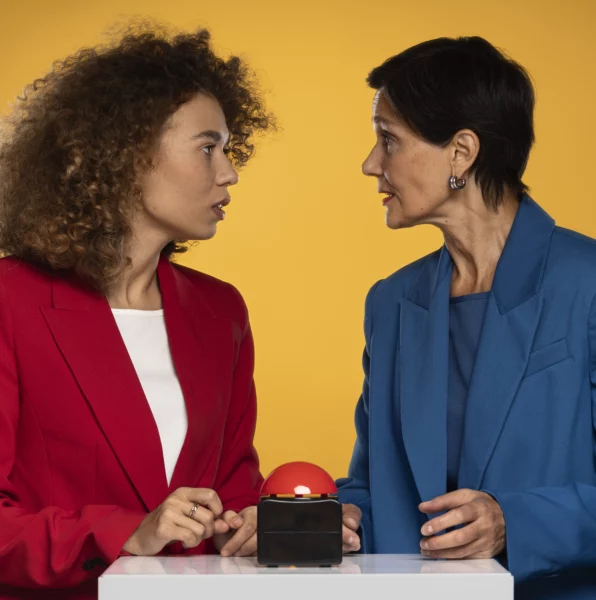Structuring information in an appealing and accessible way, just like in a good story? The ABT framework can help. Scientist and filmmaker Randy Olson explains the power behind this simple method and how it can make science communication more accessible and captivating.
How „And, But, Therefore“ improve Science Stories

„And, But, Therefore“ is what the ABT framework stands for you are teaching. What does it mean?
The ABT model really began in 1986 with Frank Daniel, a legendary screenwriting instructor at the University of Southern California. He used to say that when we write first drafts—whether it’s a screenplay, a speech, or a scientific manuscript—we often fall into the dreaded structure of „and then, and then, and then.“
In revisions, though, we start replacing those „and thens“ with „buts“ and „therefores.“ That’s when a narrative starts to take shape, engaging the audience by centering everything around the basic dynamic of problem and solution. This approach is fundamental to storytelling, debate, rhetoric, logic, comedy, and even the scientific method.
Every good story, whether it’s a murder mystery or a scientific discovery, starts with a problem and takes off on a journey to solve it. That’s where ABT comes in—it’s about finding that central, simple core that’s crucial in both evolutionary biology and entertainment.
Why should science communicators try this method?
Scientists tend to fall into rigid patterns of communication—it’s drilled into them from the start, and it’s hard to break out of that. The scientific community often fails to grasp the fundamental dynamics of communication, leading to major issues when trying to engage with the public.
The ABT model is about addressing that problem-solution dynamic. There’s an enormous communication problem in science, and until it’s acknowledged and tackled head-on, it’s just going to keep festering. ABT offers a way to structure information that’s more engaging and accessible, which is crucial if we want to avoid repeating the same mistakes over and over again.
Could you briefly explain how the model works?
At its core, the ABT (And, But, Therefore) method is about structuring communication in a way that mirrors how our brains naturally process information. It’s not something I invented—it’s a fundamental framework that’s always been there. The ABT is essentially a narrative template that breaks down to three key parts: agreement („and“), contradiction („but“), and consequence („therefore“).
This structure helps to create a clear and compelling narrative. For example, when you write a research paper, you start with what we already know („and“), then highlight what’s missing or the problem („but“), and finally, explain what you’re doing about it („therefore“). This simple template is powerful because it aligns with how we understand stories, arguments, and even scientific communication. Once you start using ABT, you see it everywhere—in speeches, papers, and even in historical documents like the Gettysburg Address, one of Abraham Lincoln’s most famous speeches.
The ABT method is about making communication clearer and more effective by focusing on this natural structure. It’s a tool that’s been around for a long time, and when used correctly, it can significantly improve how we convey complex ideas.
What are the mechanisms behind it, why does it appeal to people?
Our brains are essentially problem-solving machines, and that’s why we’re drawn to narrative structures like the ABT. The word ‚but‘ is particularly powerful because it changes the direction of a discussion and introduces conflict, which creates tension and curiosity. This is why narratives built around ‚but‘ are so compelling. Scientists often use the word ‚however‘ as a softer, more diplomatic alternative, which fits the careful nature of scientific communication.
What would you say to people who are skeptical about storytelling methods?
Let’s be clear: I’m not teaching storytelling to scientists. That’s a common misconception. What I’m really focused on is narrative structure—it’s the backbone of communication, whether you’re telling a joke, doing science, or making a movie.
Hollywood has spent over a century figuring out what makes a good story work, and they’ve nailed down some key principles, like the ‚And, But, Therefore‘ dynamic.
The problem is, academics often miss out on the visceral side of communication. They get too caught up in their heads. That’s why I’m pushing for partnerships—scientists need to team up with people who know how to communicate, like those in business and entertainment. Stand-up comedians, for example, are master communicators. They live or die by their ability to hold an audience’s attention, which is exactly what scientists need to learn.
What are some common mistakes you see people make when trying to use the technique?
One thing to really emphasize is the importance of respecting the time element, which most people overlook. The ABT structure is like solving a jigsaw puzzle—you can’t expect to solve a 10,000-piece puzzle in one afternoon. It takes time to piece together a coherent narrative.
So a common mistake is rushing the process. If you don’t invest the time upfront, you end up presenting something unfinished to the public—like a movie that loses the audience halfway through because the story wasn’t fully developed. Narrative structure is a puzzle that needs to be solved before you present it.
Another critical point in storytelling is the setup. In today’s fast-paced, information-saturated world, there’s a tendency to rush through or even skip the setup, getting straight to the action or the punchline. But this is a mistake. The setup is where you establish the context and frame the story, and without it, your narrative loses its meaning and impact.
To draw a parallel, think about telling a joke. If you skip the setup and jump straight to the punchline, you’ll likely be met with confused stares instead of laughter. However, if you craft a well-developed setup, building anticipation and framing the joke just right, the punchline can deliver a much more powerful and memorable impact.
Can the framework be implemented as a prompt for Chat GPT to perhaps edit and improve your writing?
Yes, it can be used effectively with ChatGPT to enhance your writing. For instance, during a conference, I took a 493-word abstract and asked ChatGPT to reduce it to 100 words using the ABT structure. It did a pretty good job—it wasn’t perfect, but it provided a solid starting point.
That said, narrative structure is still something AI struggles with on a deeper level. While AI can help with the heavy lifting of condensing and organizing content, it doesn’t yet fully capture the complexity and nuance that a skilled human writer can bring to narrative structure.
Finally, do you have any practical tips on how to improve the structure of your writing?
Yes, I’ve got two very practical tips to improve the structure of your texts.
First, check the frequency of the word ‚and‘ in your writing. Ideally, ‚and‘ should make up about 2.5% of your text. To check this, take a recent document you’ve written, search for the word ‚and‘ (make sure to include a space on either side so you don’t catch words like ’sand‘ or ‚hand‘), and divide the number of ‚ands‘ by the total word count. If it’s much higher than 2.5%, your writing might be too repetitive or overly complex.
Second, check your ‚but‘ to ‚and‘ ratio. This is a simple way to gauge the balance of conflict and resolution in your text. To do this, search for ‚but‘ (with a space after it) and compare it to your ‚and‘ count. Multiply the result by 100 to get a whole number. If your ratio is in the teens or twenties, you’re likely on the right track. If it’s much lower, your text might lack the necessary tension to engage readers.
These two metrics—’and‘ frequency and the ‚but‘ to ‚and‘ ratio—are quick, simple checks that can help ensure your writing is well-structured and engaging.






